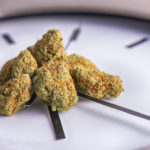You’ve probably chuckled at some of the more unusual marijuana strain names you’ve seen listed on your favorite dispensary’s menu. Eyebrow-raising names like Poochie Love, Green Crack, or Dopium may evoke an image that’s more recreational than medicinal.
But you’d be wrong to assume that the names are silly or meaningless. The names of marijuana strains have embraced the plant’s historical origins and helped shape the modern legal marijuana horticulture practices of today.
Strain naming started in the 1960s when growers across the world swapped the highest quality genetics. These early strains were typically named based on the part of the world they came from, such as Panama Red, Acapulco Gold, and Afghan Kush.
Some strains get named for unique aromas, such as diesel and skunk. Some are named for the fruit flavors that they smell like, as guided by their terpene profiles. Blueberry, Lemon OG, and Strawberry Cough are a few popular fruit strains you’ll often see on dispensary menus.
Famous people who’ve contributed to the field of cannabis in meaningful ways often get a strain named for them as well. Jack Herer, Willie Nelson, and the CBD strain Charlotte’s Web are a few examples.
How Cultivators Use Marijuana Strain Names
Marijuana strain names provide more than just a historical reference. Strain names arm medical marijuana cultivators with a handy guide to tell them what effect a particular strain might produce.
Cultivators breed strains to purify and strengthen strains, combine strain traits, or enhance specific strain characteristics. By breeding two different strains, new strains get born all the time. And that strain has to get a name. So the lineage of a strain can become quite complicated. By selectively breeding over several generations, it allows the breeder the chance to improve cannabis genetics to breed a strain that might be better than either parent.
Lawsuits and Other Complications
If you’ve ever heard of the popular strain Girl Scout Cookies, the breeders were forced to change these strain names due to legal threats from the Girl Scouts of America. Gorilla Glue strain? Same deal – a lawsuit from the glue manufacturer. This is why you’ll often see these strains listed on dispensaries as GSC or GG#4.
Another topic that’s hot in the industry regards whether adding new strain names complicates the user’s experience. In 2017, one company attempted to simplify the cannabis user’s experience. Canndescent, a distributor of ultra-premium cannabis flower in California, stopped using strain names all together. They instead adopted a descriptive, effects-based classification system: Calm, Cruise, Create, Connect and Charge.
“You shouldn’t need to bio-hack your body through a periodic table of ominous strain names like Durban Poison and Train Wreck just to buy some pot,” CEO of Canndescent Adrian Sedlin said in a press release.
Copyright law, marketing, and genetic mapping of strains might be a few key factors that play a larger role in naming cannabis strains in the future. But for now, just resist giggling when your dispensary budtender tells you to try the Purple Monkey Balls. (It’s a strain name!)
Interested to learn more about marijuana strain names? Check out the Cleveland School of Cannabis certificate programs that can help you prepare for a job in the cannabis industry.






